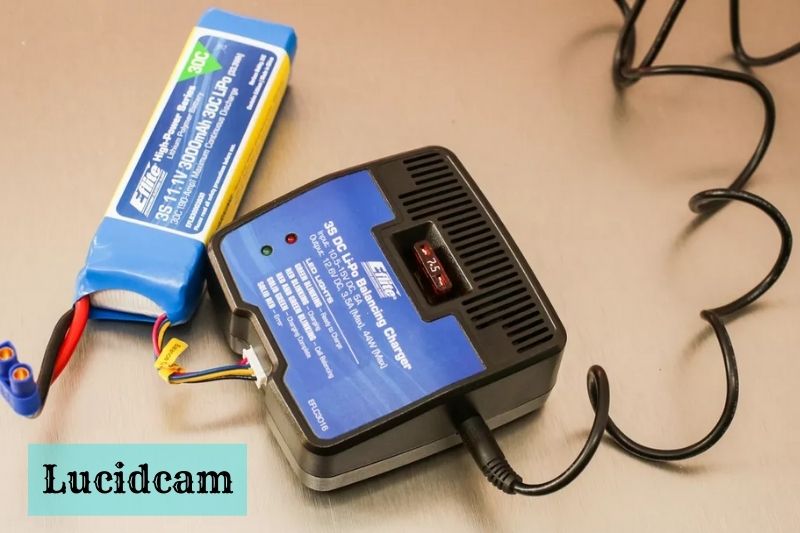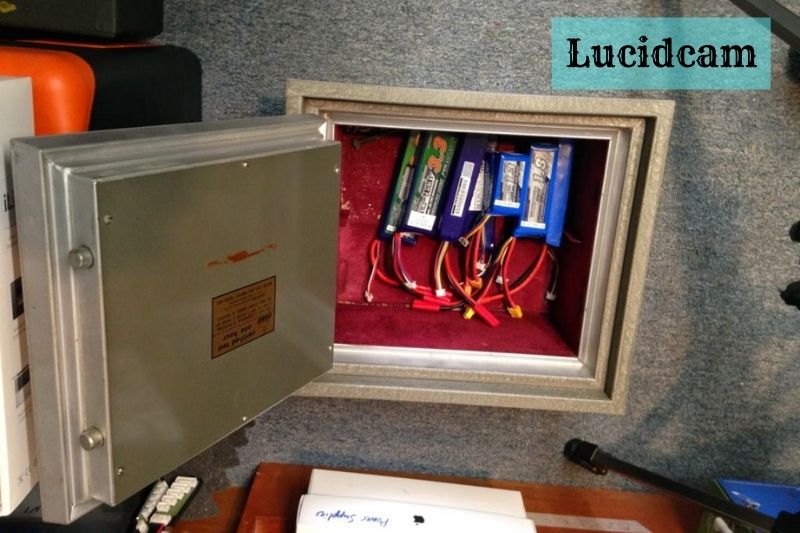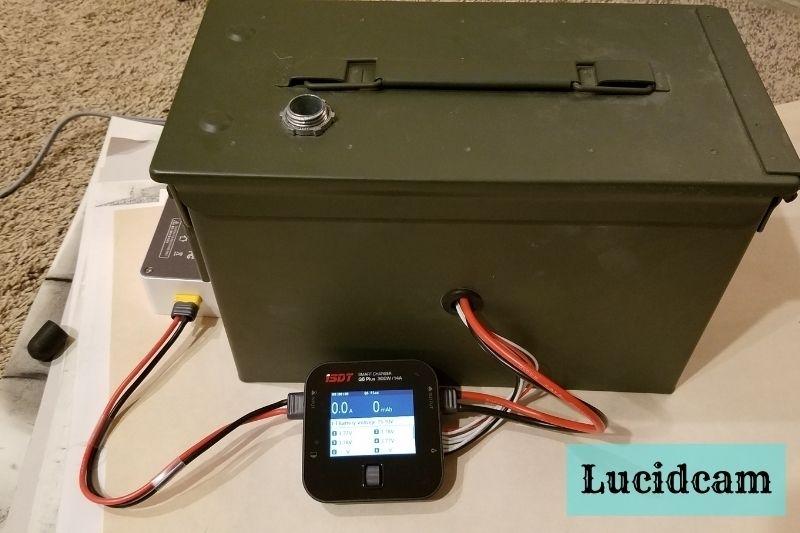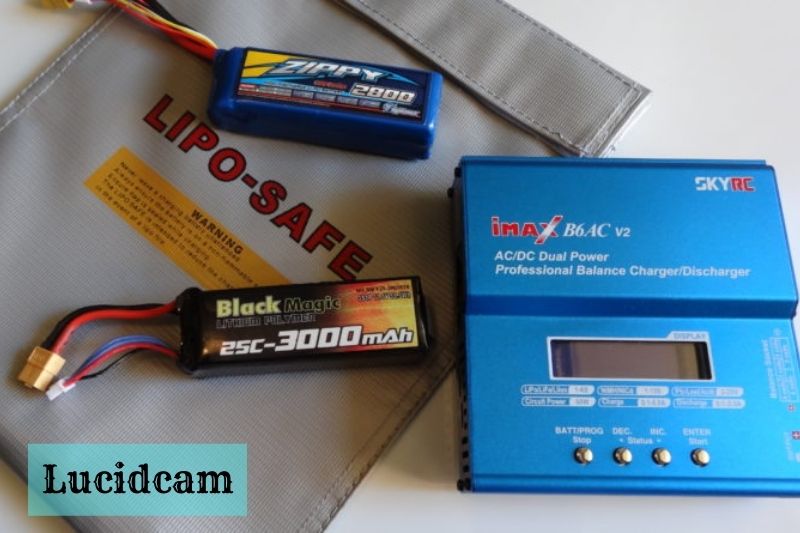Batteries are a required component of every single device that we use. Unfortunately, they also have a finite life span and will eventually need to be replaced.
You are wondering how to store lipo batteries for your drone, you’re looking for a safe and efficient way to store your lipo batteries; then this blog post is for you.
Lucidcam will go over the different types of storage available and what they offer so that you can make an informed decision about which one is right for your needs.
Table of Contents
What’s a Lipo battery?
A Lipo battery, or lithium polymer battery, is a type of rechargeable battery that uses lithium-ion technology with a polymer electrolyte instead of a liquid one. The electrolyte is composed of a high-conductivity semisolid polymer, which allows for a thinner and more flexible battery. This makes them ideal for use in small electronic devices where space is limited.
Lipo batteries have several advantages over other types of batteries, including a higher specific energy, meaning they can store more energy per unit of weight or volume. They are also less prone to leaking or exploding than other battery types, and they have a longer lifespan, meaning they can be recharged and used more times than other batteries.
Lipo batteries have been gaining popularity in recent years, especially in the radio control industry, due to their high power and long run times. They are now used in many consumer electronics devices, such as smartphones, tablets, and laptops, as well as in electric vehicles and drones.
However, Lipo batteries also have some disadvantages. They require a specific charging and discharging process to prevent damage, and they can be more expensive than other battery types. Additionally, if they are not handled properly, they can become unstable and catch fire or explode, making them potentially dangerous.

Preparing
There are some things that you should do before you store your battery.
You can store your drone after you have flown it one last time. Make sure to charge your battery up to the recommended storage level of about 60%
After your last flight, if your battery level remains above 60%, don’t worry. The battery should be programmed to automatically discharge to the recommended storage levels over a specified number of days. DJI defaults at 10 days. This can be modified in the GO App.
If your LiPo drone battery is only going to be used for a brief time, such as when you are traveling, let it discharge to between 60% and 80%.
If you are certain that your battery will be kept for a prolonged period of time (over 10 days to 90), then it is best to discharge the battery to 40% to 60%.
How to store lipo batteries

Storing Lipo batteries is an essential aspect of their maintenance, as it can prevent damage and prolong their lifespan. Here are some tips on how to store Lipo batteries safely:
- Keep batteries at a stable temperature: Lipo batteries should be stored at room temperature, between 20-25°C (68-77°F). Avoid storing them in areas that are subject to extreme temperatures or fluctuations, such as in direct sunlight or near heating sources.
- Store in a fireproof container: Lipo batteries should be stored in a fireproof container, such as a metal box, to reduce the risk of fire. Never store them in a flammable area or near materials that can ignite.
- Keep batteries charged to 50-60%: Storing Lipo batteries at full charge or discharge can cause damage and shorten their lifespan. It is recommended to store them at a 50-60% charge level to reduce stress on the battery.
- Use a battery storage bag: A battery storage bag can be used to store Lipo batteries safely, especially when traveling. These bags are fireproof and can contain any fire or explosion that may occur.
- Check batteries periodically: Even when stored, Lipo batteries can lose their charge over time. Check them periodically and recharge as necessary to maintain their charge level.
- Avoid mechanical stress: Avoid bending, puncturing, or exposing Lipo batteries to mechanical stress, as this can damage them and cause them to catch fire or explode.
Storage Voltage
A new lipo battery will be partially charged when it arrives. The Storage Voltage is the partial charge. The Storage Vol is the voltage at which each cell is charged to approximately 3.0 volts. We will cover battery cells in more detail later.
This is because a lipo battery works best at this voltage. The battery will slowly lose its efficiency and energy capacity if there is too much or too little. Therefore, it is essential to quickly charge your batteries or return them to their storage voltage after you use them.
Lipo Cell Voltage
A standard lipo battery cell can be used at a voltage of 3.2 v to 4.2 v. The battery can be permanently damaged if it drops below 3.2v. A battery that is higher than 4.2v will explode into flames.
You will typically start with a battery at a storage charge (or 3.8v), then place it on the charger. The charger will charge the battery to about 4.2v. Proper LiPo Storage Voltage = 3.8V per cell. I recommend to our customers that they put their LiPo batteries in storage mode after every run.
Next, you can fly until the voltage drops to somewhere between 3.5v and 3.7v depending on your preference. Why not fly them down to 3.2v? You can, but it puts more strain on the batteries and reduces their lifespan.
Typically, when you fly the drone and give it a boost of throttle, the battery will sag, which causes the voltage to drop. It is trying to deliver all it can power. This sag can cause the battery cell to drop below 3.2v.
Many drone batteries are made from multiple cells, so you don’t know the voltage of every cell. A battery made from six cells won’t discharge at the same speed so that you might end up with one cell charging at 3.0v and another at 3.4v.
You could end up damaging one cell or the whole battery. It is recommended that you land when your batteries reach 3.5v per cell or higher. After landing, your batteries will have a chance to recover from all the hard work.
Your 3.5v cells might stabilize at 3.6 to 3.7 volts per cell. 3.7 volts per cell is the nominal voltage. Some people will stop flying when their batteries reach 3.8v per cell so that they don’t need to store them. This will result in less flight time, but it may be worth it.
Battery cells
There are many options for drone batteries. They come in many sizes, shapes, cell counts, and connector types. Everything from a tiny single-cell battery for a “Tiny Whoop” to a large 6 cell battery is often used in drones with 5″ propellers.
They come in larger sizes than the 6 cell variety, but they are not recommended for drones with propellers of 5″. The voltage of a battery increases when multiple cells are combined to make it larger and more powerful.
A battery may also be listed as 4s2p or 2s2p. This is simply to let the buyer know that the battery has both parallel and series cells. In the example of a 4s2p, it tells you that 4 cells are wired in series and each cell is made up of 2 parallel cells for more capacity and voltage.
It is therefore essential to match the correct rpm motor with the appropriate battery voltage. We will not go into detail about that. Understanding the relationship between voltages and cell counts is crucial.
Your OSD should display the average voltage of your FPV goggles. This will make it irrelevant if you fly with a 4s battery or a 6s battery. It will simply show the average cell voltage. Once you get used to it, you can use that value to determine when you land.
A battery may also be listed as 4s2p or 2s2p. This is to let the buyer know that the battery has both parallel and series cells. The example of a 4s2p tells you that 4 cells are wired in series, and each cell is made up of 2 similar cells for more capacity and voltage.
Lipo batteries made up of more than one cell can lead to cells becoming out of balance. You want the voltage of all cells in a storm to be the same at all times. Your lipo charger offers a charging option called balance charging.
Many chargers can split into two phases: “fast charging” and “balance charge.” This will quickly charge the cells up to a level close to full, then gradually top them off. They will check the voltage of each cell as they go along to ensure they are fully charged.
Balance charging your batteries is essential for optimal health. Your 2 cell LiPo battery or larger has a second plug. The balance plug, also known as the balance plug, is used by your charger for individual monitoring and charging each cell.
You should also monitor the voltage in each cell of your battery regularly. Any lipo charger that can charge 2s batteries or more should display the voltage of each cell. You may notice that one or more of your battery cells are significantly lower than the rest after you have finished using it.
The Netherlands contacted me recently asking about parallel charging versus series charging. He wanted to know how best to charge six of his single-cell LiPo batteries at the same time.
LiPo Battery Charging
This brings us to the section about charging a lipo battery. To maximize the battery’s useful life, you should know some basics about charging. It is essential never to leave your battery charger unattended.
The chances of a fire starting are increased when a lipo battery is charged. It is implausible that a healthy, unaffected lipo will catch fire. However, FPV drones can cause damage to batteries, so it is possible to overcharge or crash charge a battery.
A charge rate of 1C, or one-time capacity, is the best way to charge a lithium battery. This will make it safer and less stressful. If you start with a battery around 3.2v, a 1C charge rate will allow the battery to be charged in one hour.
If you have a 1000mAh battery, you will charge it at 1C. Your charger should be set to 1 Amp. You would put your charger at 0.5 Amps if you had 500mAh batteries. You would set your charger to 1.5 Amps for a 1500mAh battery and 3.5 Amps for a 3500mAh one.
Although many batteries will state a maximum charging C rating on their packaging, it is better to charge faster whenever possible.
Most modern computerized chargers have a LiPo Storage function that will either charge the batteries up to that voltage or discharge them down to that voltage, whichever is necessary.
Don’t Leave a LiPo Battery Charging Unattended

It is best to charge a lipo battery once it has been charged. Once it is fully charged, you can use it immediately and return it to its storage voltage. This is because a battery that is not at its storage voltage continually degrades and can cause cumulative damage.
The most common problem people have with LiPo batteries is a direct result of improper storage. When a LiPo battery sits for a long period of time (and not at proper storage voltage), it tends to discharge itself.
Lithium-Polymer batteries can be damaged by sitting fully charged for as little as a week. This doesn’t mean they will get damaged every time you leave them for over a week.
A Lipo battery that has been left at its full charge for more than a month could have a significantly increased internal resistance, leading to a decrease in performance and heat. There is no set time limit for how long a lipo should be fully charged.
It is possible to leave it fully charged for one day, 10 times, or 10 consecutive days. It could be fully charged for 24 hours or fully charged for one day.
Most people accept leaving batteries fully charged for at least a day. If you have fully charged batteries but no plans to use them within the next day, it is best to let them go to storage voltage.
When a LiPo battery sits for a long period of time (and not at proper storage voltage), it tends to discharge itself. If it drops below 3.0V per cell, the vast majority of LiPo chargers will not charge it.
Many LiPo chargers also have a discharge setting to bring the battery down to its storage charge.
You don’t have to watch the battery the whole time. Just stay in the same room so you can react quickly if the battery catches fire.
Discharge Rate or C-Rating
LiPo batteries are well-known for their ability to produce a lot of power quickly. This is why we prefer them to other batteries such as Lithium-Ion.
The battery’s discharge rate or C-rating determines how much power it can provide continuously without damaging the battery.
Although it is controversial how accurate manufacturers’ C-ratings of their batteries are, you can easily compare C-ratings from similar batteries to get an idea of which battery delivers more power.
A majority of batteries also have a burst C rating. This rating is the power that the battery can deliver for a short burst or a few seconds without causing any damage. It will be lower than the continuous C rate.
A high burst rating is an excellent option for times when you need to go full throttle quickly. If your motors draw more power than the battery’s C-rating, it can cause damage to your battery.
Discharging (Using the Battery) LiPo batteries offer plenty of power and runtime for us radio control enthusiasts, but that power and runtime come at a price. LiPo batteries are capable of catching fire if not used properly – they are much more delicate than the older NiMH/NiCd batteries.
LiPo’s Don’t Like Extreme Temperatures
Lipo batteries are enemies to heat and cold. Lipo batteries that get too hot, especially while charging, can be damaged. On the other hand, freezing temperatures can cause a battery to lose its performance.
Keep this in mind if you fly in cold conditions. Keep your batteries warm but not too hot before you use them in cold conditions. While the batteries can be kept warm once they are in the air, you’ll find that they won’t perform as well as usual.
They will have a lower voltage and will feel more sluggish when you push them to the limits. This will result in shorter flight times and less power.
If a LiPo fire happens, the charging bag should include the flame; nevertheless, it will still port dangerous battery gasses that you shouldn’t inhale.
Most people tend toward leaving their LiPos in a LiPo bag, as they are portable and protect your workshop from catching fire should the LiPo combust. The lipo storage bag is made from fire-retardant material. In case of a fire, the bags won’t completely stifle the flames, but they may give you a little more time to react.
When storing your LiPo battery long-term, always store it at room temperature and use a proper container, like a fireproof LiPo bag.
Some people like to store their lipos in ammo boxes. You can also store the lipos in a container with a bag of sand on top.
LiPo Lifespan
LiPo batteries are limited in their lifespan. After 300 charge cycles, most LiPo batteries will lose their performance, and it is time to retire them.
You’ll notice a decrease in flight time and less “punch” than when you bought the battery new. Puffing is another indicator that a battery is ready to be disposed of. As the components within a battery become a gas, it will puff up and expand if it is abused or worn out.
Keep an eye out for the internal resistance of your battery charger. If the internal resistance of one cell is higher than the rest, it is a sign that the battery needs to be replaced.
They will last a lot longer and get more use out of them if you are kind to them. This means that they should not be over/undercharged, kept at storage voltage, and not let get too hot.
Storing batteries at home
The safety of your family and your valuables is your greatest risk if you store your battery at home. You don’t want to burn down your home. You won’t make your wife happy.
- Monthly, check the battery level. You should check the battery level every month if you plan on storing it long-term. You can charge your battery again if it drops below 40%
- Keep them outdoors. The best place to keep your drone batteries safe is outside, in a shed or garage. This is not always possible. However, there are ways to ensure everyone is safe.
- You should ensure that the drone’s battery doesn’t start to smoke or burn. This will alert you to the problem early so you can take action and remove the battery from your home. Think about if the battery was hidden somewhere, such as in an attic. It is likely that you would have noticed warning signs from an unstable LiPo drone battery by now.
- You should always have a fire extinguisher at home. You will be able to quickly extinguish the flames if the battery is ignited. Make sure that your family knows how to use a fire extinguisher in case of an emergency.
- Keep your battery safe in a bag or fireproof charging case. These bags are meant to keep the smoke out of the house and contain the flames.
- Keep your battery cool and well ventilated in a dry place. Keep it at room temperature. It should not be stored in a hot place such as a car, tool shed, or garage.
- Keep your batteries out of reach from high-flammable items. You can store cleaning products, gasoline cans and bottles, as well as large stacks of newspapers. This is fairly obvious, but it’s worth thinking about where to store them. You want to be able to control the flames as quickly as possible if the battery goes out.
- Keep them away from your most valuable possessions. You want to make sure that the damage is as minimal as possible if something goes wrong. This is an easy way to prevent it from becoming expensive.
Storing Batteries For Travelling
When traveling, it’s important to take extra precautions when storing batteries to prevent any potential safety hazards. Here are some tips on how to store batteries for traveling:
- Carry-on luggage: Always store batteries in your carry-on luggage and not in checked baggage. This is because batteries can potentially catch fire or explode if they are stored in the cargo hold of a plane.
- Original packaging: If possible, store batteries in their original packaging. This can help to prevent any potential short circuits that can occur if the batteries come into contact with metal objects such as keys or coins.
- Insulate terminals: To further reduce the risk of short circuits, it’s important to insulate the terminals of the batteries using electrical tape or plastic covers. This will prevent the terminals from coming into contact with other metal objects during transit.
- Separate batteries: It’s important to separate individual batteries from each other to prevent them from coming into contact with each other during transit. This is because when batteries are stored together, they can potentially short-circuit and cause a fire or explosion.
- Store in a cool, dry place: When traveling, it’s important to store batteries in a cool, dry place away from direct sunlight and heat sources. This is because heat can cause the batteries to degrade faster, which can lead to a reduction in battery life.
- Check for damage: Before traveling, it’s important to check the batteries for any signs of damage, such as leaks or cracks. If a battery is damaged, do not take it with you, as it can potentially cause a safety hazard.
By following these tips, you can help to ensure that your batteries remain safe during transit and that you can use them when you need them. Remember to always handle batteries with care and dispose of them safely if they become damaged or show signs of wear and tear.
LiPo Battery Disposal
Before you dispose of your LiPo make sure that the warranty has expired. You may be eligible for one-year replacement warranties from some companies. However, most warranties will be voided if the following steps are followed before you apply for a warranty replacement.
What if you have a dead LiPo battery? They are fire hazards and no one wants them to be around. What is the safest way to dispose of a bad LiPo? Let’s take a look at it.
Charge the LiPo battery to the lowest level you can. This can be done in a variety of ways. Many computerized LiPo chargers include a discharge function. You can charge your car’s battery with any charger that has a discharge function. However, this could cause a fire or damage your vehicle. You can also make your own discharge rig using a taillight bulb, some wire, and some glue. Connect the male connector to the taillight bulb tabs and then plug in the battery. While doing this, make sure the battery is in a fireproof container.
Put the LiPo into a saltwater bath. Combine table salt with warm water (but not hot). Continue adding salt to the water until it is no longer dissolves. Make sure that all wires are completely submerged. Salt-water is highly conductive and will shorten the battery. The salt-water bath should be left on for at least 24hrs.
Verify the voltage of your LiPo. Great! Next, move on to the next step. If it is not possible to do so, place the battery in the saltwater bath for 24 more hours. Keep doing this until your battery is at 0.0V.
Throw away the battery in the trash. LiPos, unlike NiMH or NiCd batteries, are safe for the environment. They can be thrown away without any problems.
LiPo Batteries Charging Tips
LiPo batteries are a popular choice for powering a variety of devices, including remote control cars, drones, and portable electronics. However, it’s important to charge them properly to ensure their longevity and prevent any potential safety hazards. Here are some tips on how to charge LiPo batteries:
- Use a LiPo charger: Always use a charger designed specifically for LiPo batteries. These chargers are designed to safely charge LiPo batteries and prevent overcharging or undercharging. Using a charger not specifically designed for LiPo batteries can potentially cause a fire or explosion.
- Charge in a safe area: When charging LiPo batteries, it’s important to do so in a safe area away from flammable materials. It’s also recommended to charge the batteries on a fireproof surface to prevent any potential fire hazards.
- Use a balance charger: A balance charger is a charger that can charge each cell of a LiPo battery individually. This helps to ensure that each cell is charged to the same voltage, which is important for maintaining the health and longevity of the battery.
- Set the charge rate: When charging LiPo batteries, it’s important to set the charge rate according to the manufacturer’s recommendations. Charging at a rate that is too high can potentially damage the battery and reduce its lifespan. It’s also recommended to never charge a LiPo battery at a rate higher than 1C, which means one times the capacity of the battery. For example, if you have a 2000mAh battery, you should charge it at a maximum rate of 2 amps.
- Monitor the battery: When charging LiPo batteries, it’s important to monitor the battery to ensure that it doesn’t overheat or overcharge. If you notice that the battery is getting hot or swelling, stop charging it immediately and allow it to cool down. It’s also recommended to use a LiPo safe bag or container to further reduce the risk of fire or explosion.
- Store batteries properly: After charging LiPo batteries, it’s important to store them properly to ensure their longevity. As mentioned earlier, store them in a cool, dry place away from direct sunlight and heat sources. It’s also recommended to store them at a voltage between 3.7V and 3.85V per cell to ensure that they remain in good condition.
Handling and Storage of LiPo Batteries
- Keep LiPo batteries out of reach of children.
- Avoid putting batteries in Lipo bags or pockets where they could short circuit.
- Avoid storing or transporting batteries near sharp or metallic objects.
- Avoid purchasing used LiPo batteries.
- Keep your LiPo packs out of direct sunlight.
- Keep your LiPo Pack in a non-flammable, safe container. The best storage container for LiPo is a LiPo Sack, metal or ceramic.
- Your LiPo’s should always be kept partially charged. They will retain their performance over time, and you don’t need to cycle them if they are kept for longer than 3-6 months.
- Avoid soaking the battery in water.
- Do not throw away in heat or fire.
- For safety reasons, ship LiPo batteries at least 30% charged when you send them.
- For extended battery storage, keep them at half charge.
- For disposal of a LiPo Battery, fully discharge it and then put it in a bucket with salt water for at least one week. Follow your local battery disposal guidelines to dispose of it.
FAQs Lipo Battery Storage
What should you not do with a Lipo battery?
Lithium Polymer must be CHARGED and STORED in a fire-safe container like a Lipo Sack. Do not charge batteries near flammable items or liquids. Keep a dry fire extinguisher nearby or a large bucket of dry sand, which is a cheap and effective extinguisher. Never charge inside an automobile even when parked.
Read more: https://www.maxamps.com/lipo-care.php
Is it OK to leave a Lipo battery charge overnight?
Never leave your LiPo batteries charging while unattended. If a battery starts to become puffy, smoke, or catches fire you need to be able to immediately handle the situation.
Read more: https://www.thedronegirl.com/2015/02/07/lipo-battery/
Can LiPo batteries explode in storage?
Lipo (Lithium-polymer) batteries are huge in the RC industry. They have taken over the old technology of Nimh (Nickel-metal hydride) and Nicad (Nickel-cadmium) batteries. They are superior in longevity and constant current but they do have their downsides. The quick answer is yes, they can explode and catch fire.
Read more: https://racingrccar.com/lipo-battery-safety/
Conclusion
The information in this article should provide a general understanding of how to charge lipo batteries for drone flying. If you have any questions, feel free to contact us or leave comments below! We hope that the tips and tricks we’ve provided will be helpful when it comes time to charge your battery packs. Now get out there and fly responsibly!

